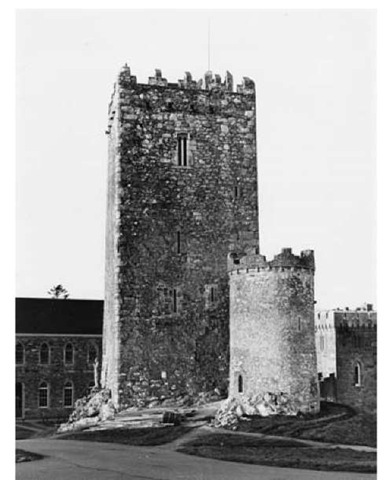The history of Cork may be traced to the foundation of a monastery, reputedly by St. Finbarr, around 606. Already by the late seventh century it was one of the foremost ecclesiastical settlements in Ireland. Its abbot was numbered among the leading Irish churchmen at the synod of Birr (697). Its law school had a national reputation. A contemporary law tract accorded its abbot the same status as the king of Munster. Nonetheless, early Christian Cork was the location of a monastery and not of a town.
Drishane Castle, Co. Cork.
Cork experienced its first recorded Viking incursion in 820. In 846 there was a Viking fortress at Cork, possibly the "castle" destroyed in 865. A Viking town may have developed at Cork from the early tenth century, though it has left little impression in historical records and has so far eluded systematic archaeological study. Following the Meic Carthaig revolt against Muirchertach Ua Briain in 1118, Cork became the capital of the kingdom of Desmond (South Munster). The Meic Carthaig constructed a major castle at Shan-don, immediately north of Cork. It seems that the town grew under Meic Carthaig auspices, with a mixed population of Irish and Scandinavians.
According to contemporary Irish annals, contradicting Giraldus Cambrensis, Cork was seized and sacked by English knights in 1177. Cork was granted the status of a royal borough by Prince John around 1189. From the early thirteenth century the two central islands of Cork, an area of 14.5 hectares, were enclosed with great stone walls. It was necessary to raise the level of the ground within the walled town considerably to prevent periodic flooding. The channel between the islands was transformed into docks shielded by a fortified ship-gate, as reflected in Cork’s coat of arms.
Cork’s trade increased tremendously in volume, first with Bristol and then with southwestern France. Its population grew commensurately, with many people employed in handling traded goods and in processing animal hides and foodstuffs. By the early fourteenth century there was considerable suburban development at Shandon and Fayth, subordinate boroughs on the north and south banks of the Lee. Archaeologists have found evidence of housing of improved quality and greater density.
The fourteenth century proved calamitous for Cork. Climatic deterioration, and the breakdown of law and order in its rural hinterland, reduced the volumes of agricultural surplus available for processing and trading in Cork. These economic difficulties were compounded by the Black Death, which exacted a heavy toll on the city. For a century after the plague there is very little trace in the archaeological record of Cork’s overseas trade.
The recovery of the English economy from the mid-fifteenth century, and the increased order imposed on Cork’s hinterland by the MacCarthys and the earls of Desmond, facilitated a modest revival in Cork’s economic fortunes. Much of the increased wealth, however, was concentrated in the hands of a small mercantile oligarchy. They monopolized control of the corporation and they built impressive tower houses for themselves within the city walls, or nearby. The examination of skeletal remains from St. Mary’s Dominican priory shows that for most medieval Corkonians, life was short and very hard. Nonetheless, the advent of the Tudors seemed to promise a continued amelioration in Cork’s fortunes.

